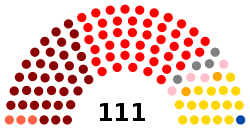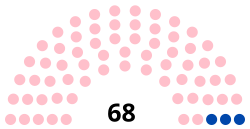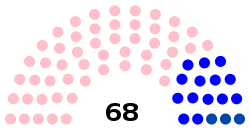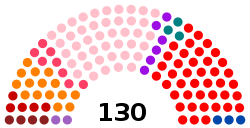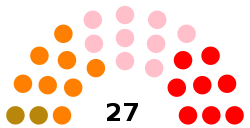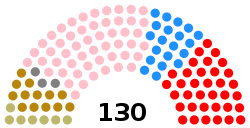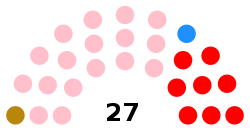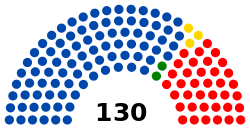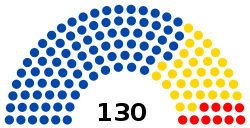Plurinational Legislative Assembly of Bolivia
The Plurinational Legislative Assembly (ALP) is the legislative body of the public power of the Plurinational State of Bolivia. The Plurinational Legislative Assembly is made up of two chambers: the Chamber of Deputies with 130 members, and the Chamber of Senators with 36 members. The Assembly meets in the new legislative building in La Paz.
The powers of the legislative body are established in the Political Constitution of the State, and its organization and functions are regulated by the General Regulations of the Chamber of Deputies.
Senate
The Senate has 36 members, four representatives from each Department. Senators are elected from party lists. The term of office of the senators is five years and they can be re-elected once continuously.
Chamber of Deputies
The Chamber of Deputies has 130 members: In each department, half of the deputies are elected in single-member constituencies (65 deputies). The other half (65 deputies) are elected in multi-member departmental constituencies, from the lists headed by the candidates for president, vice president and state senators. Deputies also have a term of five years and must be at least 18 years old on the day of the election.
La Paz has 29 deputies; Santa Cruz 28; Cochabamba 19, Potosi 13; Chuquisaca 10; Tarija and Oruro with 9; Beni 8; and Pando 5.
Salaries
In 2006, the former president of the Plurinational State of Bolivia, Evo Morales Ayma, decreed the reduction of his salary by more than half, as well as that of the vice president and all the deputies, senators, ministers and vice ministers, this with the objective of giving a little more austerity to the Bolivian state. These measures generated criticism from the opposition towards the national government and fierce opposition from Congress.
Titular senators and deputies
| Year | Monthly salary | Average daily | Equivalence at US$ dollars |
| 2000 | Bs 18 881 | Bs 630 | US$ 3 060 |
| 2001 | Bs 18 881 | Bs 630 | US$ 2 865 |
| 2002 | Bs 18 881 | Bs 630 | US$ 2 640 |
| 2003 | Bs 18 881 | Bs 630 | US$ 2 471 |
| 2004 | Bs 18 881 | Bs 630 | US$ 2 383 |
| 2005 | Bs 18 881 | Bs 630 | US$ 2 348 |
| 2006 | Bs 10 500 | Bs 350 | US$ 1 319 |
| 2007 | Bs 10 500 | Bs 350 | US$ 1 347 |
| 2008 | Bs 10 500 | Bs 350 | US$ 1 462 |
| 2009 | Bs 10 500 | Bs 350 | US$ 1 508 |
| 2010 | Bs 11 500 | Bs 416 | US$ 1 652 |
| 2011 | Bs 12 500 | Bs 450 | US$ 1 816 |
| 2012 | Bs 14 400 | Bs 480 | US$ 2 098 |
| 2013 | Bs 16 800 | Bs 560 | US$ 2 448 |
| 2014 | Bs 18 480 | Bs 616 | US$ 2 693 |
| 2015 | Bs 19 260 | Bs 642 | US$ 2 807 |
| 2016 | Bs 20 050 | Bs 668 | US$ 2 922 |
| 2017 | Bs 21 453 | Bs 713 | US$ 3 127 |
| 2018 | Bs 22 525 | Bs 750 | US$ 3 283 |
| 2019 | Bs 22 633 | Bs 754 | US$ 3 299 |
| 2020 | Bs 22 633 | Bs 754 | US$ 3 299 |
| 2021 | Bs 22 633 | Bs 754 | US$ 3 299 |
| 2022 | Bs 22 633 | Bs 754 | US$ 3 299 |
Alternate senators and deputies
| Year | Monthly salary | Average daily | Equivalence at US$ dollars |
| 2006 | Bs 4 500 | Bs 150 | US$ 565 |
| 2007 | Bs 4 500 | Bs 150 | US$ 577 |
| 2008 | Bs 4 500 | Bs 150 | US$ 626 |
| 2009 | Bs 4 500 | Bs 150 | US$ 646 |
| 2010 | Bs 4 600 | Bs 153 | US$ 660 |
| 2011 | Bs 4 700 | Bs 156 | US$ 683 |
| 2012 | Bs 4 800 | Bs 160 | US$ 700 |
| 2013 | Bs 5 600 | Bs 186 | US$ 816 |
| 2014 | Bs 6 160 | Bs 205 | US$ 897 |
| 2015 | Bs 6 420 | Bs 214 | US$ 935 |
| 2016 | Bs 6 683 | Bs 222 | US$ 974 |
| 2017 | Bs 7 151 | Bs 238 | US$ 1 042 |
| 2018 | Bs 7 508 | Bs 250 | US$ 1 094 |
| 2019 | Bs 7 544 | Bs 251 | US$ 1 099 |
| 2020 | Bs 7 544 | Bs 251 | US$ 1 099 |
| 2021 | Bs 7 544 | Bs 251 | US$ 1 099 |
| 2022 | Bs 7 544 | Bs 251 | US$ 1 099 |
Offices
The Legislative Power was itinerant, between 1825 and 1900 sessions were held in various parts of the country Sucre, La Paz, Cochabamba, Oruro, and even one in Tapacarí.
Freedom House
The House of Freedom in the city of Sucre, was the first building of the Bolivian Legislative Power, it was there where the parliamentary republican life of Bolivia began. The Jesuits built this building as part of a convent in the 17th century. In the colony it was the main classroom of the Universidad Mayor Real y Pontificia de San Francisco Xavier de Chuquisaca. Later in 1767 it was the headquarters of the famous Carolina Academy, dependent on the Audiencia de Charcas.
Originally, it had characteristics of viceregal architecture, after its destruction it changed to the neoclassical style. Subsequently, a new restoration was carried out on the occasion of celebrating the centenary of the Republic. In 1973 it was restored, under the direction of the architect Cristina Damm, recovering its original colonial architecture.
La Casa de la Libertad was the venue where the General Assembly of Deputies of the Provinces of Upper Peru met and later to sign the Act of Independence on August 6, 1825 that gave birth to the Republic of Bolivar. The pioneers were Manuel María Urcullo, José Mariano Serrano, Casimiro Olañeta, Manuel Sánchez de Velasco, José Miguel Lanza, José Ballivián, and José Ignacio de Sanjinés. After the Federal Revolution, the palace moved to La Paz but on occasions it held sessions in the Casa de la Libertad, such as in 1925, on the occasion of the sesquicentennial of the founding of Bolivia in 1975, in 1995 and in 2005 to debate the resignation of the President Carlos Mesa, his succession and possession of President Eduardo Rodríguez Veltzé.
La Paz Legislative Palace
Before the change of seat of government, many governments were sworn in in La Paz such as Manuel Isidoro Belzu (1851), José María de Achá (1861), Agustín Morales (1872), Tomás Frías Ametller (1872), Adolfo Ballivián (1873), Hilarión Daza Groselle (1876), Narciso Campero (1880) and Aniceto Arce (1884).
From the Federal Revolution to the present, the Plurinational Legislative Assembly operates in the Legislative Palace in La Paz located in Plaza Murillo, this building was previously part of the College of the Company of Jesus, then it was destined for the Carolino Seminary and finally, before being the Legislative Palace, it was a hall of the Universidad Mayor de San Andrés.
In 1890, José Manuel Pando began the construction of a Legislative Palace, which was inaugurated in 1905, with a neoclassical style. In 1925, to commemorate the centenary of the Republic in the government of Bautista Saavedra Mallea, new modifications were made to the Legislative Palace.
In 2016, construction began on a modern building that expands the current Legislative Palace on the land located behind the current Legislative Palace.
New building
The two houses of the Assembly meet in the Legislative Palace located in Plaza Murillo, the main square of La Paz. In Plaza Murillo you can also find the presidential palace (known as the Palacio Quemado due to attempts to destroy it several times in the 19th century) and the Cathedral of Nuestra Señora de La Paz.
The Vice President, in his capacity as President of the Assembly, has an office in a building on Calle Mercado, in the center of La Paz. This Vice-Presidency building was originally built to be the location of the Central Bank of Bolivia. Under the government of Jaime Paz Zamora (1989 - 1993), the building was reassigned to the vice-presidency, but the vice-president's advisory staff did not move to that location until 1997. This building also houses the Legislative Assembly Library and the Assembly File.
Elections
Elections for senators and representatives are held every 5 years. Although there have been long and drawn-out exceptions, they have been made with universal suffrage since 1956; and continuously, since the recovery of democracy in 1982, to date.
1931 Election
The 1931 Bolivian parliamentary elections were held on February 4, in these elections Daniel Salamanca presented himself as the only presidential candidate with the Genuine Republican Party, winning the elections, together with the vice-presidential candidate José Luis Tejada Sorzano with the Liberal Party, winning over Bautista Saavedra Mallea of the Republican Party. Congress was arranged mostly by Liberals and Genuine Republicans.
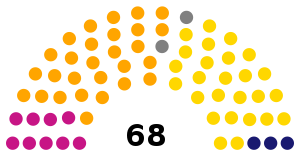  | |||
| Party | Deputies | Senators | |
|---|---|---|---|
| Liberal Party | 26 | 10 | |
| Genuine Republican Party | 28 | 5 | |
| Socialist Republican Party | 9 | 1 | |
| Nationalist Party | 3 | 0 | |
| Independent | 2 | 0 | |
| Total | 68 | 16 | |
1933 Election
In these parliamentary elections, half of the Chamber of Deputies and a third of the Senate were renewed. They were held in May 1933. These elections were held during the Chaco War. On November 11, 1934, new elections were held to choose a new president and a new National Congress, but the results of this election were later annulled. The terms of the senators and representatives elected in 1933 and who were in office were extended until August 5, 1936.
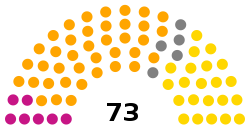  | |||||
| Party | Scalls | ||||
|---|---|---|---|---|---|
| Camera | Senate | ||||
| Total | +/- | Total | +/- | ||
| Genuine Republican Party | 39 | +11 | 1 | -4 | |
| Liberal Party | 22 | -4 | 8 | -2 | |
| Socialist Republican Party | 7 | -2 | 1 | 0 | |
| Other | 5 | +3 | 5 | +5 | |
| Vacancies | 1 | ||||
| Total | 73 | +5 | 15 | -1 | |
1938 Election
The parliamentary elections in Bolivia of 1938 were held on March 13, a parliament that also served as the formation of a new Constituent Assembly. On May 28, 1938, this Constituent Assembly confirmed President Germán Busch Becerra as constitutional president, who had assumed the presidency on July 13, 1937 as a result of a coup. This Assembly was the one that promulgated the Constitution of 1938, this Assembly was dissolved by the same president who declared himself dictator on April 24, 1939, after declaring himself dictator he promoted the most important changes in his administration.
 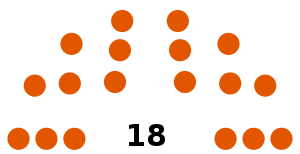 | |||
| Party | Deputies | Senators | |
|---|---|---|---|
| Single Socialist Front | 96 | 18 | |
| Independent | 5 | 0 | |
| Independent leaders of La Paz | 2 | 0 | |
| Total | 103 | 18 | |
1940 Elections
The 1940 general election was held on March 10. They were carried out with the "qualified vote" system. In these elections, Enrique Peñaranda won as candidate for Concordance, a political alliance of traditional right-wing parties (Liberal Party; Genuine Republican Party; Socialist Republican Party) and the army attached to power. The leftist opposition candidate was José Antonio Arze for the Partido de la Izquierda Revolucionaria.
1942 Election
In these parliamentary elections, half of the Chamber of Deputies and a third of the Senate were renewed. They were made in March 1942.
1944 Election
The parliamentary elections in Bolivia of 1944 were held on July 2, a parliament that served at the same time as the formation of a new Constituent Assembly. On August 4, 1944, this Constituent Assembly confirmed President Gualberto Villarroel López as constitutional president, who had assumed the presidency on December 20, 1943 as a result of a coup. This Assembly was the one that promulgated the Constitution of 1945, where the constitutional president had a term of 6 years, a time that Gualberto Villarroel López could not serve after his overthrow and fatal outcome on July 21, 1946. Another Constituent Assembly was not held until the Constituent Assembly of Bolivia of 2006.
1947 Election
The general elections of 1947 were held on January 3. These elections were held using the "qualified vote" system. This congress chose to ratify the first majority Enrique Hertzog Garaizabal and Mamerto Urriolagoitia Harriague after the resignation of Luis Fernando Guachalla.
1949 Election
In these parliamentary elections, half of the Chamber of Deputies and a third of the Senate were renewed. They were held on May 1, 1949. This was the last Congress elected before the 1952 Revolution and the last elected before universal suffrage.
1956 Election
The general elections of 1956 were held on June 17. These elections were the first held with universal suffrage, the first held after the 1952 Revolution, and the first held after the annulment of the 1951 elections.
1958 Election
In these parliamentary elections, half of the Chamber of Deputies and a third of the Senate were renewed. They were made on June 20, 1958.
1960 Elections
The general elections of 1960 were held on May 5. For the first time the Revolutionary Nationalist Movement appeared divided in two, the official one with Víctor Paz Estenssoro and Juan Lechín Oquendo; and the Authentic Revolutionary Party of Walter Guevara Arze. The result was overwhelming in favor of the Movimiento Nacionalista Revolucionario, leaving the conformation of the Congress as follows:
1962 Election
In the parliamentary elections of 1962, a portion of the Chamber of Deputies and the Senate were renewed. They were made on June 4, 1962.
1964 Election
The 1964 general election was held on May 31. Víctor Paz Estenssoro of the Movimiento Nacionalista Revolucionario (MNR) decided to run for re-election, despite opposition from left and right parties of the time, for which reason he was the only candidate for president, and the other parties only presented parliamentary candidacies. This action by Paz caused the division of the Movimiento Nacionalista Revolucionario (MNR) into various wings and factions. The MNR retained its vast majority in Congress after the renewal of a portion of the Chamber of Deputies and the Senate.
1966 Election
The 1966 general elections were held on Sunday, July 3, 1966 in the government of Alfredo Ovando Candía, the first elections held after the coup carried out by General René Barrientos Ortuño and General Alfredo Ovando Candía in 1964 Six candidacies were presented for the presidency of Bolivia, but none with the possibility of facing the official candidacy of the formula René Barrientos Ortuño and Luis Adolfo Siles Salinas. Víctor Paz Estenssoro and Hernán Siles Suazo, who could not stand in the elections, were then banned. This legislature of 1966, acted as Constituent Congress when preparing and later approving the Political Constitution of the State of 1967.
These elections would be the last before the 12 years of military dictatorship, with the composition of this Congress as follows:
1979 Elections
After the great electoral fraud of 1978 in the government of General Hugo Banzer Suárez, who chose his Interior Minister General Juan Pereda Asbún as the official candidate, they were annulled when a gigantic fraud in favor of the official candidate was verified. After the annulment of the elections, a crisis broke out and Pereda decided to launch a coup against his mentor. A few months into government, Pereda was dismissed by a coup by General David Padilla Arancibia, who called elections as the first measure.
The 1979 general elections were held on Sunday, July 1, 1979. No candidate obtained more than half of the votes, a deadlock ensued, and it was up to the National Congress to choose the president among the most voted candidates, but they were unable to to reach an agreement, for which a consensual solution was reached to elect Walter Guevara Arze president of the Senate as interim president of the Republic for one year, pending new elections. Decree Law 16095 of January 11, 1979 defined a minimum of five deputies per department and one for every 50,000 inhabitants (except for departmental capitals), and established that each department would elect three senators. Decree Law 16331 of April 5, 1979 established the number of seats for representatives and senators to be assigned to each department, the composition of Congress being as follows:
1980 Elections
The 1980 general elections were held on Sunday, June 29, 1980 and were chaired by the then president, Lidia Gueiler Tejada. The National Congress had to choose the new president among the first three majorities after no candidate obtained more than 50% of the votes. This process was to be carried out on August 6, 1980; However, on July 17, a coup led by General Luis García Meza occurred. After the general strike that left the country practically on the verge of civil war on September 17, 1982, the military government at that time in the hands of General Guido Vildoso Calderón decided to reinstate the Congress elected in 1980, and the legislature decided on September 23 revalidate the presidential election of 1980, taking place on October 5, the date on which Hernán Siles Zuazo was elected president of Bolivia. He assumed his position on October 10, 1982.
1985 Election
After the crisis of the Democratic and Popular Unity, there were arduous negotiations between the ruling party and the opposition where an agreement was reached to ask President Hernán Siles Zuazo to resign from a year in office and call elections in mid-1985. The general elections of 1985 were held on Sunday, July 14, 1985 to elect the President of the Republic and the senators and deputies of the National Congress. Since no candidate obtained more than half of the votes, it corresponded to the National Congress to choose the president among the most voted candidates. For the first time in the history of Bolivia, the congress elected the second, Víctor Paz Estenssoro, as president, and the composition of the Congress was as follows:
1989 Elections
The general elections of 1989 were held on Sunday, May 7, 1989. Since no candidate obtained more than half of the votes, it corresponded to the National Congress to designate the president among the three most voted candidates, for the first time in history of Bolivia, the congress elected the third party, Jaime Paz Zamora, as president, and the composition of the Congress was as follows:
1993 Election
The 1993 general elections were held on Sunday, June 6, 1993. Since no candidate obtained more than half of the votes, it was up to the National Congress to choose the president among the candidates with the most votes. Gonzalo Sánchez de Lozada was elected president, and the composition of the Congress was as follows:
1997 Elections
The 1997 general elections were held on Sunday, June 1. Since no candidate obtained more than half of the votes, the National Congress decided among the candidates with the highest number of votes. Hugo Banzer Suárez was re-elected president and the composition of the Congress is as follows:
Elections 2002
The 2002 general elections were held on June 30, 2002. Since no candidate obtained more than half of the votes, the National Congress chose among the candidates with the highest number of votes. Gonzalo Sánchez de Lozada was re-elected president, receiving 84 votes in Congress against 43 votes for Evo Morales Ayma, the composition of Congress being as follows:
2005 Elections
The next election was to take place in June 2007, but the social crisis and delicate institutional situation that Bolivia continued to experience during 2005 led to its being brought forward, and the 2005 general elections were held on December 18 of the same year. The final results give an absolute majority of more than 54% of votes to Evo Morales and the National Congress was not needed to decide between the candidates with the most votes. The Congress was composed as shown in the following table:
2009 Elections
On December 6, 2009, the 2009 general elections were held in Bolivia, after the 2006 Bolivian Constituent Assembly, the 2009 Bolivian Constitutional Referendum held on January 25, 2009, and the promulgation of the Bolivian Constitution of 2009 on February 7, 2009 at a massive event in the city of El Alto.
Evo Morales, from the Movimiento al Socialismo, was re-elected, ensuring his continuity in office until 2015. In these elections, the 130 deputies and 36 senators who will make up the Plurinational Assembly were also elected. International observers sent by the OAS and the European Union endorsed the electoral process and highlighted the "tranquility, massive participation and democratic legitimacy" of the elections
2014 Election
On October 12, 2014, the 2014 general elections were held in Bolivia. Evo Morales, from the Movimiento al Socialismo, was re-elected, ensuring his continuity in office until 2020. In these elections, the 130 deputies and 36 senators who will make up the Plurinational Assembly were also elected. The Assembly was controlled in both chambers by the Movement for Socialism, which had more than 2/3. These elections were the second under the Bolivian Constitution of 2009, and the first controlled and verified by the new Plurinational Electoral Body. The terms of the senators and deputies were extended until November 3, 2020, by Law 1270 due to the controversial 2019 general elections that were accused of fraudulent and due to the COVID-19 pandemic in Bolivia that forced the postponement of the new general elections. of 2020. From this Chamber of Senators, the Second Vice President of the Senate Jeanine Áñez Chávez was proclaimed President of Bolivia on November 12, 2019 after the conflicts unleashed after the election results, the resignation of Evo Morales Ayma, of Vice President Álvaro García Linera and the presidents of both chambers, thus proclaiming Añez without the necessary quorum President of the State.
2020 Election
On October 18, 2020, the final results give a victory in the first round with 55.11% of the votes to Luis Arce. The Assembly is controlled by a majority in both chambers by the Movimiento al Socialismo. These elections were held after the controversial 2019 Elections where the government was accused of electoral fraud. In addition, these elections were postponed due to the COVID-19 pandemic in Bolivia.
Contenido relacionado
Architecture in the United States
Seismogenic faults in the Region of Murcia
Storm bog









